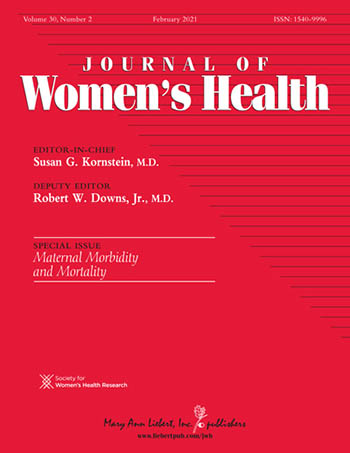Research Briefs: Maternal Morbidity and Mortality
Journal of Women’s Health Special Issue Discusses Maternal Morbidity and Mortality

A special issue of the Journal of Women’s Health (JWH) characterizes the increasing problem of maternal morbidity and mortality (MMM) in the United States. Articles in the issue suggest solutions and propose a research agenda for understanding, treating, and preventing maternal health complications. U.S. women—particularly those from underrepresented racial and ethnic populations and those who reside in rural areas—are more likely to die from complications related to pregnancy or childbirth than women in peer nations. Office of Research on Women’s Health (ORWH) Associate Director Samia Noursi served as the guest editor for the JWH special issue and, along with NIH leadership colleagues, wrote the introduction. The authors state that the articles describe “epidemiological patterns and trends, biological and physiological risk factors, external risk factors, social determinants of health, and proven and potential interventions that are poised to be delivered to a broader audience.” Many NIH scientists contributed articles to the issue.
Maternal health disparities in U.S. subpopulations. Several JWH articles discuss how many United States subpopulations—including underrepresented racial and ethnic groups, transgender individuals, and women of advanced maternal age—have higher rates of MMM as a result of socioeconomic disadvantages, comorbidities, implicit bias, and other factors. Joia Crear-Perry and colleagues discuss how influences on the health-care system—including individual, clinical, behavioral, social, historical, systemic, structural, and political determinants—and their intersection with race, class, sex, and gender contribute to the problem of MMM. An article by Jennifer L. Heck and colleagues reviews the available literature on MMM in American Indian and Alaska Native women; identifies hemorrhage, cardiomyopathies, and hypertensive disorders of pregnancy as leading causes of maternal mortality in this population; and points to the numerous knowledge gaps on MMM in this group. Juanita J. Chinn, of NICHD, and colleagues describe persistent MMM health disparities among Black women relative to other U.S. women and discuss associated comorbidities and relevant structural inequities within and outside of the health -system. Finally, ORWH graduate intern Bani Saluja and former ORWH research scientist Zenobia Bryant discuss implicit bias and its contribution to racial disparities in MMM in the United States.
Comorbidities and MMM. Women with medical conditions predating conception or conditions that emerge during pregnancy experience higher rates of MMM than women with no comorbidities. Several articles in the special issue of JWH discuss how the risk of MMM increases as the result of co-occurring conditions such as dysglycemia, physical and cognitive disability, cardiovascular disease, perinatal depression, sleep-disordered breathing, and infection. Several articles also discuss evidence-based clinical practices for monitoring and treating such patients before, during, and after pregnancy.
Additional MMM considerations. The JWH articles also explore other factors contributing to and issues associated with MMM, including homicide, suicide, drug overdose, and intimate partner violence; environmental factors; and dietary supplements during pregnancy. ORWH Special Advisor David A. Thomas and colleagues discuss pain and pain management during pregnancy. An article by ORWH Senior Program Officer Régine Douthard and colleagues considers the problem of MMM in a global context.
Addressing the Problem of MMM. Two articles focus on current and proposed efforts to mitigate the problem of MMM in the United States. Catherine Squire Eppes and NIH colleagues describe the implementation of new clinical tools and protocols (or “care bundles”) designed to improve obstetric safety. An article by Beda Jean-François and colleagues discusses how existing health information technologies could be leveraged to address health disparities in MMM stemming from racial, ethnic, socioeconomic, and geographic factors.
A New Research Agenda. Michael Lu and Noursi discuss all articles and conclude the JWH special issue by proposing a new MMM research agenda for the biomedical community. Synthesizing the contents of the JWH articles, Lu and Noursi identify four key questions indicating where scientific knowledge is lacking:1) Why are some populations at higher risk for MMM? 2) How can we prevent pregnancy complications and their long-term effects? 3) How can we improve the safety and quality of maternity care? and 4) What are the social, structural, and environmental determinants of maternal health? These questions suggest an agenda for the next stages of research and provide a guide to biomedical investigators, policymakers, and funding organizations addressing MMM.
This page was last updated on Tuesday, February 15, 2022
